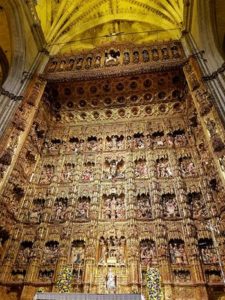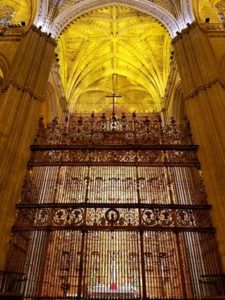
The art historian, José Gestoso y Pérez has expressed that ” The Spirit pales when considering the presumptuous prodigious material work and inventiveness which truly represents the world of art, its colossal proportions, the attention and dedication to its carvings, the infinite enriched details which escape the most penetrating eye and the exquisite taste in this work produces an utter awe.”
 The design of the work of art represented in this altarpiece is considered the greatest in all of Christianity was executed by the Flemish sculptor Pedro Dancart in 1482. The work was performed for over eighty years being completed finally in 1564. During those years, various Spanish and foreign craftsmen continued the work begun by Dancart. Among these; Pedro Millán, Jorge Fernández Alemán, Roque Balduque, Juan Bautista Vázquez el Viejo and Pedro de Heredia.
The design of the work of art represented in this altarpiece is considered the greatest in all of Christianity was executed by the Flemish sculptor Pedro Dancart in 1482. The work was performed for over eighty years being completed finally in 1564. During those years, various Spanish and foreign craftsmen continued the work begun by Dancart. Among these; Pedro Millán, Jorge Fernández Alemán, Roque Balduque, Juan Bautista Vázquez el Viejo and Pedro de Heredia.
Pedro Dancart’s original designed called for an altarpiece 20 meters high by 18 meters wide and to include a total of 28 different scenes of the life of Christ and the Virgin Mary. In 1550, the council decide to enlarge the original dimensions in order to add 16 addicional scenes from the Old and New Testaments, increasing the number to 44.
The chapel containing this altarpiece is enclosed by a large fence made of forged iron and gold during the XVI century. This fence is the work of the Dominican monk and iron worker Francisco de Salamanca and is comprised of three bodies.
Pictures LVYEM
